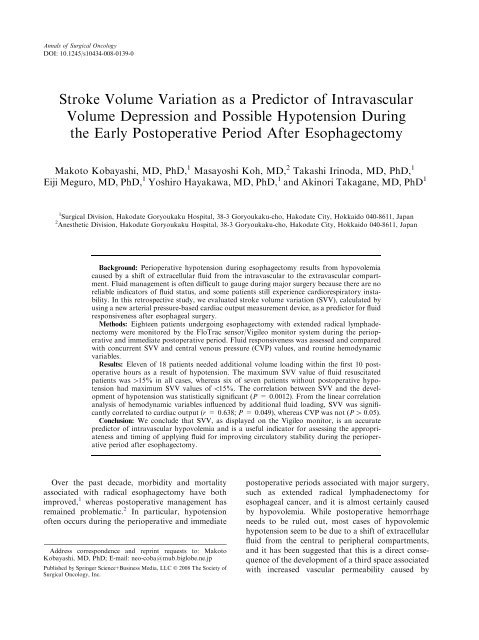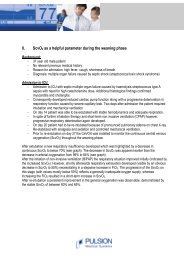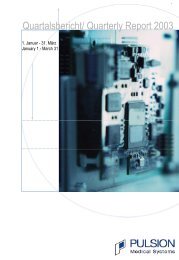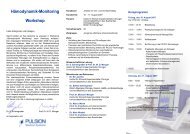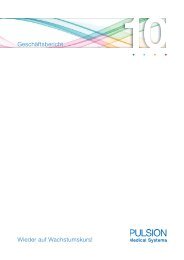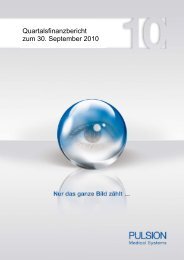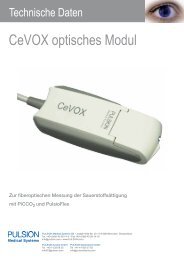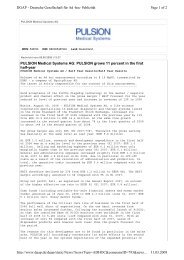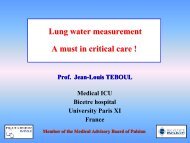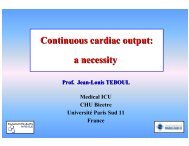Stroke Volume Variation as a Predictor of Intravascular Volume ...
Stroke Volume Variation as a Predictor of Intravascular Volume ...
Stroke Volume Variation as a Predictor of Intravascular Volume ...
Create successful ePaper yourself
Turn your PDF publications into a flip-book with our unique Google optimized e-Paper software.
Annals <strong>of</strong> Surgical Oncology<br />
DOI: 10.1245/s10434-008-0139-0<br />
<strong>Stroke</strong> <strong>Volume</strong> <strong>Variation</strong> <strong>as</strong> a <strong>Predictor</strong> <strong>of</strong> Intrav<strong>as</strong>cular<br />
<strong>Volume</strong> Depression and Possible Hypotension During<br />
the Early Postoperative Period After Esophagectomy<br />
Makoto Kobay<strong>as</strong>hi, MD, PhD, 1 M<strong>as</strong>ayoshi Koh, MD, 2 Tak<strong>as</strong>hi Irinoda, MD, PhD, 1<br />
Eiji Meguro, MD, PhD, 1 Yoshiro Hayakawa, MD, PhD, 1 and Akinori Takagane, MD, PhD 1<br />
1 Surgical Division, Hakodate Goryoukaku Hospital, 38-3 Goryoukaku-cho, Hakodate City, Hokkaido 040-8611, Japan<br />
2 Anesthetic Division, Hakodate Goryoukaku Hospital, 38-3 Goryoukaku-cho, Hakodate City, Hokkaido 040-8611, Japan<br />
Background: Perioperative hypotension during esophagectomy results from hypovolemia<br />
caused by a shift <strong>of</strong> extracellular fluid from the intrav<strong>as</strong>cular to the extrav<strong>as</strong>cular compartment.<br />
Fluid management is <strong>of</strong>ten difficult to gauge during major surgery because there are no<br />
reliable indicators <strong>of</strong> fluid status, and some patients still experience cardiorespiratory instability.<br />
In this retrospective study, we evaluated stroke volume variation (SVV), calculated by<br />
using a new arterial pressure-b<strong>as</strong>ed cardiac output me<strong>as</strong>urement device, <strong>as</strong> a predictor for fluid<br />
responsiveness after esophageal surgery.<br />
Methods: Eighteen patients undergoing esophagectomy with extended radical lymphadenectomy<br />
were monitored by the FloTrac sensor/Vigileo monitor system during the perioperative<br />
and immediate postoperative period. Fluid responsiveness w<strong>as</strong> <strong>as</strong>sessed and compared<br />
with concurrent SVV and central venous pressure (CVP) values, and routine hemodynamic<br />
variables.<br />
Results: Eleven <strong>of</strong> 18 patients needed additional volume loading within the first 10 postoperative<br />
hours <strong>as</strong> a result <strong>of</strong> hypotension. The maximum SVV value <strong>of</strong> fluid resuscitated<br />
patients w<strong>as</strong> >15% in all c<strong>as</strong>es, where<strong>as</strong> six <strong>of</strong> seven patients without postoperative hypotension<br />
had maximum SVV values <strong>of</strong> 0.05).<br />
Conclusion: We conclude that SVV, <strong>as</strong> displayed on the Vigileo monitor, is an accurate<br />
predictor <strong>of</strong> intrav<strong>as</strong>cular hypovolemia and is a useful indicator for <strong>as</strong>sessing the appropriateness<br />
and timing <strong>of</strong> applying fluid for improving circulatory stability during the perioperative<br />
period after esophagectomy.<br />
Over the p<strong>as</strong>t decade, morbidity and mortality<br />
<strong>as</strong>sociated with radical esophagectomy have both<br />
improved, 1 where<strong>as</strong> postoperative management h<strong>as</strong><br />
remained problematic. 2 In particular, hypotension<br />
<strong>of</strong>ten occurs during the perioperative and immediate<br />
Address correspondence and reprint requests to: Makoto<br />
Kobay<strong>as</strong>hi, MD, PhD; E-mail: neo-coba@mub.biglobe.ne.jp<br />
Published by Springer Science+Business Media, LLC Ó 2008 The Society <strong>of</strong><br />
Surgical Oncology, Inc.<br />
postoperative periods <strong>as</strong>sociated with major surgery,<br />
such <strong>as</strong> extended radical lymphadenectomy for<br />
esophageal cancer, and it is almost certainly caused<br />
by hypovolemia. While postoperative hemorrhage<br />
needs to be ruled out, most c<strong>as</strong>es <strong>of</strong> hypovolemic<br />
hypotension seem to be due to a shift <strong>of</strong> extracellular<br />
fluid from the central to peripheral compartments,<br />
and it h<strong>as</strong> been suggested that this is a direct consequence<br />
<strong>of</strong> the development <strong>of</strong> a third space <strong>as</strong>sociated<br />
with incre<strong>as</strong>ed v<strong>as</strong>cular permeability caused by
hypercytokinemia. 3 The destruction <strong>of</strong> the lymphatic<br />
tract due to interruption <strong>of</strong> the pulmonary lymph<br />
outflow tract <strong>as</strong> a result <strong>of</strong> medi<strong>as</strong>tinal lymphadenectomy<br />
and removal <strong>of</strong> the thoracic duct also promotes<br />
deterioration <strong>of</strong> circulatory dynamics. 4 With<br />
the introduction <strong>of</strong> minimally inv<strong>as</strong>ive surgery, 5 corticosteroid<br />
administration to prevent hypercytokinemia,<br />
6,7 and treatment with a specific neutrophil<br />
el<strong>as</strong>t<strong>as</strong>e inhibitor, 8 postoperative management <strong>of</strong><br />
esophageal cancer is safer than ever. However, it is<br />
also true that some patients still experience cardiorespiratory<br />
instability; especially those with poor<br />
preoperative nutrition and those receiving neoadjuvant<br />
chemoradiotherapy. 9,10 Even when it is thought<br />
that sufficient fluid h<strong>as</strong> been administered, it is<br />
sometimes difficult to determine whether intrav<strong>as</strong>cular<br />
fluid depression h<strong>as</strong> been relieved by monitoring<br />
routine hemodynamic parameters. An added complication<br />
is that although appropriate fluid transfusion<br />
is <strong>of</strong>ten crucial to avoid the deleterious effects <strong>of</strong><br />
overresuscitation, underresuscitation, or inappropriate<br />
resuscitation, it is also reported that static indicators<br />
<strong>of</strong> cardiac preload, such <strong>as</strong> central venous<br />
pressure (CVP), pulmonary artery occlusion pressure,<br />
and cardiac end-di<strong>as</strong>tolic dimensions, may be unreliable<br />
in detecting volume responsiveness in critically<br />
ill patients. 11<br />
The FloTrac sensor in combination with the Vigileo<br />
monitor (Edwards Lifesciences, Tokyo, Japan) is<br />
a recently introduced arterial pressure-b<strong>as</strong>ed system<br />
for continuously monitoring cardiac output (CO),<br />
which h<strong>as</strong> applicability in the critical care setting. The<br />
FloTrac sensor is a less inv<strong>as</strong>ive hemodynamic<br />
monitoring device than those used for thermodilution<br />
<strong>as</strong>sessment, and it can be used to monitor continuously<br />
CO, stroke volume, and stroke volume variation<br />
(SVV) through a peripheral arterial pressure line.<br />
In addition, other CO devices require calibration to<br />
correct for the patient’s changing v<strong>as</strong>cular tone,<br />
where<strong>as</strong> the FloTrac sensor/Vigileo monitor system<br />
needs no calibration because it continuously adjusts<br />
for the patient’s ever-changing v<strong>as</strong>cular tone by use<br />
<strong>of</strong> a novel algorithm incorporated within the Vigileo<br />
monitor, which is applied to the digitized arterial<br />
pressure wave. 12 The usefulness <strong>of</strong> SVV in <strong>as</strong>sessing<br />
fluid responsiveness h<strong>as</strong> previously been reported in<br />
patients with reduced cardiac function. 13 We started<br />
routinely using the FloTrac sensor/Vigileo monitor<br />
system during esophageal surgery, including an<br />
<strong>as</strong>sessment <strong>of</strong> its advantages for perioperative management<br />
after radical esophagectomy, in May 2006.<br />
This followed early findings that indicated that SVV<br />
w<strong>as</strong> very good at predicting the development <strong>of</strong><br />
Ann. Surg. Oncol.<br />
M. KOBAYASHI ET AL.<br />
hypercytokinemia-induced intrav<strong>as</strong>cular hypovolemia<br />
in patients undergoing major surgery.<br />
Here we report retrospective results from the first<br />
18 patients undergoing surgery for esophageal cancer<br />
in whom the FloTrac sensor/Vigileo monitor system<br />
w<strong>as</strong> used to <strong>as</strong>sess fluid responsiveness <strong>as</strong> an integral<br />
part <strong>of</strong> routine postoperative management follow-up<br />
and care. In addition, we compared SVV with CVP in<br />
terms <strong>of</strong> reliability in predicting fluid responsiveness<br />
during the perioperative and postsurgical periods.<br />
MATERIALS AND METHODS<br />
Between May 2006 and September 2007, 18 men <strong>of</strong><br />
mean ± standard deviation age 66.8 ± 4.8 (range, 61–<br />
73) years underwent perioperative monitoring with<br />
the FloTrac sensor/Vigileo monitor system after<br />
curative esophagectomy for esophageal squamous<br />
cell carcinoma at Hakodate Goryoukaku Hospital.<br />
The tumor, node, met<strong>as</strong>t<strong>as</strong>is system cl<strong>as</strong>sification<br />
according to the Guidelines for the Clinical and<br />
Pathologic Studies on Carcinoma <strong>of</strong> the Esophagus<br />
(Japan Society for Esophageal Dise<strong>as</strong>es, 9th edition)<br />
w<strong>as</strong> <strong>as</strong> follows: stage I, n = 5; stage II, n = 5; stage<br />
III, n = 4; and stage IVa, n = 4. Tumor location<br />
w<strong>as</strong> upper thoracic esophagus, n = 3; middle thoracic<br />
esophagus, n = 13; and lower thoracic esophagus,<br />
n = 2. Two-field lymph node dissection w<strong>as</strong><br />
performed in 5 patients and three-field dissection in<br />
13 patients. A combination <strong>of</strong> general (intravenous<br />
prop<strong>of</strong>ol) and epidural (bupivacaine) anesthesia w<strong>as</strong><br />
used to manage perioperative anesthetic requirements<br />
during surgery. The surgical approach for tumor<br />
resection for all patients w<strong>as</strong> made by intercostal<br />
thoracotomy through a 10- to 12-cm skin incision,<br />
preserving the latissimus dorsi and serratus anterior<br />
muscle. After subtotal esophagectomy and extended<br />
medi<strong>as</strong>tinal lymph node dissection, reconstruction via<br />
stomach and cervical esophagog<strong>as</strong>trostomy w<strong>as</strong><br />
performed. All patients were selected for posterior<br />
medi<strong>as</strong>tinal reconstruction via a g<strong>as</strong>tric tube, and a<br />
hand-sutured an<strong>as</strong>tomosis w<strong>as</strong> conducted at the<br />
neck site. During the surgical procedure, fluid w<strong>as</strong><br />
administered at a rate <strong>of</strong> 12 to 15 mL/kg/h <strong>of</strong> crystalloids.<br />
Perioperative dopamine or furosemide w<strong>as</strong><br />
not permitted.<br />
After surgery, all patients were immediately<br />
transferred to the intensive care unit (ICU) under<br />
tracheal intubation. Mechanical ventilation w<strong>as</strong><br />
adjusted to supply tidal volumes <strong>of</strong> 8 to 10 mL/kg <strong>of</strong><br />
preoperative body weight with pressure-support<br />
ventilation. Midazolam and morphine were admin-
istrated intravenously for sedation during tracheal<br />
intubation.<br />
Fluid administration in the early postoperative<br />
period w<strong>as</strong> started at a rate <strong>of</strong> 3.5 mL/kg/h and<br />
continued until an extrav<strong>as</strong>cular to intrav<strong>as</strong>cular<br />
shift w<strong>as</strong> observed. Patients were considered to be<br />
hypotensive when systolic blood pressure could not<br />
be maintained above 80 mm Hg for longer than<br />
15 minutes, at which time additional volume loading<br />
w<strong>as</strong> provided. If the serum albumin concentration<br />
dropped below the normal range (3.4 to 5.4 g/dL),<br />
250 mL <strong>of</strong> 5% pl<strong>as</strong>ma protein fraction w<strong>as</strong> administered.<br />
In lieu <strong>of</strong> corticosteroid treatment to treat<br />
hypercytokinemia, sivelestat sodium hydrate, a specific<br />
neutrophil el<strong>as</strong>t<strong>as</strong>e inhibitor (El<strong>as</strong>pol, Ono<br />
pharmacy, Tokyo, Japan), w<strong>as</strong> administrated intravenously<br />
at a rate <strong>of</strong> 0.2 mg/kg/h on completion <strong>of</strong><br />
surgery. To avoid the possibility <strong>of</strong> intrav<strong>as</strong>cular<br />
hypoperfusion, our policy is not to use low-dose<br />
dopamine or loop diuretics to protect against oliguria<br />
until after adjustments have been made for<br />
volume depression. After confirming circulatory<br />
stability and a shift toward diuresis, the rate <strong>of</strong><br />
fluid administration w<strong>as</strong> immediately decre<strong>as</strong>ed to<br />
1.5 mL/kg/h to avoid congestive heart failure<br />
developing <strong>as</strong> a consequence <strong>of</strong> overhydration.<br />
Patients were then weaned from <strong>as</strong>sisted mechanical<br />
ventilation.<br />
Assessment <strong>of</strong> Hemodynamic Parameters<br />
Before surgery, hemodynamic monitoring w<strong>as</strong> initiated<br />
via a 22-gauge el<strong>as</strong>tic catheter that w<strong>as</strong> inserted<br />
into the radial artery and connected to a FloTrac<br />
sensor. CO and SVV were me<strong>as</strong>ured every 20 seconds<br />
according to the algorithm housed within the Vigileo<br />
monitor. Other parameters routinely monitored<br />
included, continuous electrocardiography, pulse<br />
oximetry, end-tidal CO2 and arterial blood pressure<br />
(ABP). A central venous catheter w<strong>as</strong> inserted into<br />
the internal jugular vein, and CVP w<strong>as</strong> me<strong>as</strong>ured<br />
continuously during the perioperative period with a<br />
low-pressure transducer. All raw data from the Vigileo<br />
monitor were recorded directly onto a computer<br />
and were subsequently reviewed and analyzed statistically.<br />
To <strong>as</strong>sess hemodynamic variability <strong>as</strong>sociated<br />
with volume loading mean SVV, CVP and CO were<br />
determined 30 minutes before and 30 minutes after<br />
fluid administration. To investigate the relation<br />
between changes in preload and postload variables,<br />
changes (D) in SVV, CVP, and CO were calculated by<br />
the following formul<strong>as</strong>:<br />
SVV AFTER ESOPHAGECTOMY<br />
DSVVð%Þ ¼preload SVV postload SVV<br />
DCVP ðmm HgÞ ¼postload CVP preload CVP<br />
DCO ¼ðpostload CO preload COÞ=preload CO.<br />
Statistical Analysis<br />
All data are expressed <strong>as</strong> mean ± SD, unless stated<br />
otherwise. The v 2 test for independence w<strong>as</strong> used to<br />
<strong>as</strong>sess the relationship between SVV and the development<br />
<strong>of</strong> postoperative hypotension. To determine<br />
whether changes in hemodynamic variables (DSVV,<br />
DCVP) were related to the incre<strong>as</strong>ed ratio in CO<br />
(DCO) after additional volume loading, both linear<br />
regression and Pearson’s correlation coefficient were<br />
calculated by StatView s<strong>of</strong>tware (Abacus Concepts,<br />
Berkeley, CA). Values <strong>of</strong> P < 0.05 were considered<br />
statistically significant.<br />
RESULTS<br />
The mean duration <strong>of</strong> surgery w<strong>as</strong> 303 ± 58 minutes,<br />
and mean blood loss w<strong>as</strong> 280 ± 320 mL. Postoperatively,<br />
11 <strong>of</strong> 18 patients required additional<br />
volume loading within the first 10 hours due to<br />
hypotension, and 3 <strong>of</strong> these received blood transfusions.<br />
The mean duration under mechanical <strong>as</strong>sist<br />
ventilation after surgery w<strong>as</strong> 1.7 ± 0.7 days. The<br />
mean lengths <strong>of</strong> ICU and hospital stay after surgery<br />
were 3.6 ± 1.4 days and 16.0 ± 3.2 days, respectively.<br />
There w<strong>as</strong> no significant difference in cardiac function,<br />
<strong>as</strong> <strong>as</strong>sessed by echocardiographically me<strong>as</strong>ured<br />
ejection fraction before surgery, in patients who needed<br />
fluid resuscitation after hypotension (69.1 ± 7.2%)<br />
compared with those who did not (66.1 ± 8.8%;<br />
P = 0.390, Mann-Whitney U-test). Furthermore,<br />
there w<strong>as</strong> no statistically significant difference in the<br />
volume <strong>of</strong> fluid administered (14.1 ± 3.8 vs. 16.1 ± 3.5<br />
mL/kg/h; P = 0.2204, Mann-Whitney U-test), blood<br />
loss (241 ± 165 vs. 427 ± 332 mL; P = 0.092, Mann-<br />
Whitney U-test), or operating time (293 ± 39 vs.<br />
294 ± 70 minutes; P = 0.9025, Mann-Whitney Utest)<br />
between the group requiring fluid resuscitation<br />
versus the group that did not.<br />
Importantly, in this series <strong>of</strong> patients who had<br />
undergone esophagectomy with extended radical lymphadenectomy<br />
and who developed intrav<strong>as</strong>cular volume<br />
depression, ICU management with appropriate<br />
fluid replacement for critical hypotension (<strong>as</strong> predicted<br />
by SVV changes on the Vigileo monitor) resulted in<br />
resuscitation and recovery in all c<strong>as</strong>es and no clinically<br />
Ann. Surg. Oncol.
FIG. 1. Postoperative SVV, CO, and CVP in a patient with circulatory instability after esophagectomy in a 69-year-old man. Duration <strong>of</strong><br />
surgery w<strong>as</strong> 237 minutes; blood loss w<strong>as</strong> 127 mL. Pathological cl<strong>as</strong>sification according Japanese guidelines (see Materials and Methods) w<strong>as</strong><br />
pT3 pN0 M0 pIM0; pStage II. SVV, stroke volume variation; CO, cardiac output; CVP, central venous pressure; PPF, pl<strong>as</strong>ma protein<br />
fraction.<br />
important medical problems such <strong>as</strong> renal dysfunction,<br />
respiratory failure, cardiac insufficiency, or death<br />
occurred. Furthermore, there were no complications<br />
<strong>as</strong>sociated with the use <strong>of</strong> the FloTrac sensor/Vigileo<br />
monitoring system in this cohort <strong>of</strong> patients.<br />
Figure 1 shows a typical graphical presentation for<br />
SVV, CO, and CVP in a patient who underwent<br />
esophagectomy with three-field lymph node dissection.<br />
This patient experienced postoperative hypotension<br />
and required fluid resuscitation in the ICU.<br />
The initial SVV <strong>of</strong> the patient at the time <strong>of</strong> entering<br />
the ICU w<strong>as</strong> 8%, but it gradually incre<strong>as</strong>ed to 15% to<br />
20% by postoperative hour 4. Shortly thereafter,<br />
systolic ABP decre<strong>as</strong>ed to 80 mm Hg, but SVV still incre<strong>as</strong>ed to 26%. ABP<br />
once again dropped to 20%, and hypotension reoccurred.<br />
After additional fluid resuscitation, the circulation<br />
stabilized, and SVV w<strong>as</strong> finally maintained near 10%.<br />
During these events, CVP values showed almost no<br />
response before or after volume loading, where<strong>as</strong> the<br />
change in SVV observed graphically on the Vigileo<br />
monitor clearly predicted hypotension resulting from<br />
intrav<strong>as</strong>cular hypovolemia. In contr<strong>as</strong>t, Fig. 2 shows<br />
the typical graphical presentation for SVV, CVP, and<br />
CO in a patient with stable circulation without any<br />
hypotensive events. CO and ABP remained stable,<br />
Ann. Surg. Oncol.<br />
M. KOBAYASHI ET AL.<br />
and SVV remained 15% at any stage during the 12 hours after surgery.<br />
In contr<strong>as</strong>t, maximum SVV values in the patient<br />
group with hypotension were >15% in all c<strong>as</strong>es<br />
(n = 11), even though the initial SVV value w<strong>as</strong><br />
15% is statistically significantly higher<br />
than in patients with maximum SVV <strong>of</strong>
P = 0.049). In this small cohort <strong>of</strong> patients, the<br />
correlation between SVV and CO only just achieved<br />
statistical significance, but it did show promise <strong>as</strong> a<br />
predictor <strong>of</strong> circulatory instability induced by intrav<strong>as</strong>cular<br />
hypovolemia after esophagectomy. In this<br />
regard it, w<strong>as</strong> clearly superior to CVP.<br />
DISCUSSION<br />
Hypovolemic hypotension induced by hypercytokinemia<br />
is <strong>of</strong>ten observed in the early postoperative<br />
SVV AFTER ESOPHAGECTOMY<br />
FIG. 2. Postoperative SVV, CO, and CVP in a patient with circulatory stability after esophagectomy in a 61-year-old man. Duration <strong>of</strong> the<br />
operation w<strong>as</strong> 335 minutes; blood loss w<strong>as</strong> 82 mL. Pathological cl<strong>as</strong>sification w<strong>as</strong> pT2 pN3 M0 IM1, pStage II. SVV, stroke volume variation;<br />
CO, cardiac output; CVP, central venous pressure.<br />
FIG. 3. Initial and maximum intensive care unit (ICU) stroke volume variation (SVV) values. Patients are divided into 2 groups according to<br />
need <strong>of</strong> fluid resuscitation after postoperative hypotension caused by intrav<strong>as</strong>cular hypovolemia. The initial value <strong>of</strong> SVV on entering the ICU<br />
(j) and the maximum value before fluid resuscitation figures (•) are presented.<br />
period <strong>of</strong> esophagectomy for esophageal cancer, and<br />
it is reported that >60% <strong>of</strong> patients develop hypotension<br />
on the operative day. 14 Postoperative hypotension<br />
is <strong>of</strong>ten <strong>as</strong>sociated with a further reduction in<br />
intrav<strong>as</strong>cular volume caused by unusual shift <strong>of</strong><br />
extracellular fluid into the third space. 3 Even though<br />
an effective strategy for hypercytokinemia can be<br />
adopted that uses corticosteroids or a specific neutrophil<br />
el<strong>as</strong>t<strong>as</strong>e inhibitor such <strong>as</strong> sivelestat, and even<br />
though early weaning from mechanical ventilation is<br />
possible, 8 some patients still experience severe circulatory<br />
instability. The usual protocol in our institute<br />
Ann. Surg. Oncol.
FIG. 4. Responsiveness <strong>of</strong> CO according to changes in CVP and SVV after fluid loading. DSVV (%) = preload SVV - postload SVV; DCVP<br />
(mm Hg) = postload CVP - preload CVP; DCO = (postload CO - preload CO)/preload CO; SVV, stroke volume variation; CO, cardiac<br />
output; CVP, central venous pressure.<br />
for the perioperative management <strong>of</strong> patients undergoing<br />
esophagectomy is to administer fluid during<br />
anesthesia at a rate <strong>of</strong> 15 mL/kg/h <strong>of</strong> crystalloids.<br />
After transfer to the ICU, fluid administration starts<br />
at a rate <strong>of</strong> 3.5 mL/kg/h. Our strategy for minimizing<br />
effects related to the adverse rele<strong>as</strong>e <strong>of</strong> the neutrophil<br />
el<strong>as</strong>t<strong>as</strong>e is to administer sivelestat rather than a corticosteroid,<br />
and we also avoid the use <strong>of</strong> dopamine<br />
and furosemide. By means <strong>of</strong> this protocol, in 18<br />
patients with esophageal cancer undergoing radical<br />
esophagectomy, 15 patients (83%) were successfully<br />
extubated within 2 days after surgery without complication,<br />
and the mean period w<strong>as</strong> 1.7 days after<br />
surgery. Seven <strong>of</strong> 18 patients avoided hypotension<br />
and escaped additional volume loading, but 11 patients<br />
(61%) needed fluid resuscitation to treat<br />
intrav<strong>as</strong>cular hypovolemia.<br />
Precise control <strong>of</strong> fluid balance is a primary goal <strong>of</strong><br />
postoperative management after surgery, but traditional<br />
hemodynamic monitoring parameters (heart<br />
rate, mean arterial pressure, and CVP) are <strong>of</strong>ten<br />
insensitive and sometimes misleading in the <strong>as</strong>sessment<br />
<strong>of</strong> circulating blood volume. 15 From May 2006, our<br />
institute introduced the FloTrac sensor/Vigileo monitor<br />
system for tracking SVV during the perioperative<br />
period <strong>of</strong> esophagectomy. It w<strong>as</strong> reported that SVV<br />
calculated from stroke volume changes within the<br />
respiratory cycle under mechanical ventilation could<br />
be used to <strong>as</strong>sess the volume status and cardiac preload<br />
<strong>of</strong> critically ill 16 and cardiac surgery patients. 17 Our<br />
early clinical experience <strong>of</strong> applying the FloTrac sensor/Vigileo<br />
monitor system to patients with esophageal<br />
cancer, also demonstrated that monitoring changes in<br />
Ann. Surg. Oncol.<br />
M. KOBAYASHI ET AL.<br />
SVV accurately predicted the development <strong>of</strong> hypotension<br />
in patients undergoing esophageal surgery.<br />
In our series, the initial value <strong>of</strong> SVV on entering to<br />
the ICU w<strong>as</strong>15% in all c<strong>as</strong>es, and<br />
the occurrence rate <strong>of</strong> hypotension w<strong>as</strong> statistically<br />
significantly higher (P = 0.0012) in these patients<br />
(Fig. 3). These data indicate that an incre<strong>as</strong>e in SVV<br />
above 15% might usefully be used to predict the<br />
development <strong>of</strong> hypotension and the need for additional<br />
fluid during the early postoperative period,<br />
even when traditional parameters (e.g., mean arterial<br />
pressure, CVP, heart rate) may not highlight such<br />
changes. In the literature concerning the accuracy <strong>of</strong><br />
SVV for estimating fluid responsiveness after cardiac<br />
surgery, it h<strong>as</strong> been reported that real-time monitoring<br />
<strong>of</strong> SVV is a more sensitive and specific predictor<br />
than CVP and other hemodynamic parameters. 18 Our<br />
SVV-b<strong>as</strong>ed data is the first pertaining to esophagectomy<br />
patients and confirms that SVV also h<strong>as</strong> excellent<br />
predictive qualities in this group <strong>of</strong> patients<br />
undergoing esophageal surgery. Comparing CVP and<br />
SVV for their predictability in <strong>as</strong>sessing fluid responsiveness<br />
(Fig. 4) indicated that a decre<strong>as</strong>e in SVV<br />
values w<strong>as</strong> significantly correlated to CO improvement<br />
(r = 0.638, P = 0.049), but no such correlation<br />
between CVP and CO value existed. CVP, which is a<br />
commonly used parameter for the evaluation <strong>of</strong><br />
intrav<strong>as</strong>cular volume status, 11,17 demonstrated no<br />
predictive value for cardiorespiratory instability during<br />
the perioperative period after esophagectomy.
Although the usefulness <strong>of</strong> SVV is clearly demonstrated<br />
in our data, the clinical use <strong>of</strong> this hemodynamic<br />
parameter h<strong>as</strong> certain limitations. First, this<br />
monitoring method can only be used in mechanically<br />
ventilated patients without arrhythmi<strong>as</strong>. Moreover,<br />
severe peripheral constriction and aortic regurgitation<br />
may affect absolute values. Nevertheless, despite<br />
these limitations, we suggest that the FloTrac sensor/<br />
Vigileo monitor system provides marked advantages<br />
over more traditional vital sign monitoring systems<br />
alone in postoperative fluid resuscitation after<br />
esophageal surgery. Because individual responses to<br />
surgical stress from this form <strong>of</strong> surgery vary and are<br />
difficult to predict, perioperative cardiorespiratory<br />
instability is more unpredictable than after cardiac<br />
surgery. 19 Even though relatively large amounts <strong>of</strong><br />
fluid were transfused during the surgical procedures<br />
reported, postoperative hypotension resulting from<br />
intrav<strong>as</strong>cular hypovolemia still occurred unexpectedly.<br />
This is a predicament for the physician, who h<strong>as</strong><br />
difficult decisions to make with regards fluid resuscitation.<br />
Persistent hypotension can lead to serious<br />
tissue hypoperfusion and organ distress, while<br />
excessive fluid replacement may lead to congestive<br />
heart failure and pulmonary edema during volume<br />
resuscitation. To maintain low mortality rates in<br />
esophagectomy, a safer and more exact fluid management<br />
method is required.<br />
On the b<strong>as</strong>is <strong>of</strong> our experience to date, we conclude<br />
that SVV, <strong>as</strong> displayed on the Vigileo monitor, is an<br />
accurate predictor <strong>of</strong> intrav<strong>as</strong>cular hypovolemia and<br />
is a useful indicator for <strong>as</strong>sessing the appropriateness<br />
and timing <strong>of</strong> applying fluid for improving circulatory<br />
stability during the perioperative period after<br />
esophagectomy. A larger, prospective trial is needed<br />
to help <strong>as</strong>certain the overall effectiveness <strong>of</strong> SVV/<br />
Vigileo monitoring.<br />
ACKNOWLEDGMENT<br />
We thank Steve Clissold, PhD (Content Ed Net),<br />
who provided <strong>as</strong>sistance with English language and<br />
whose work w<strong>as</strong> funded by Edwards Lifesciences,<br />
Japan.<br />
REFERENCES<br />
1. Ando N, Ozawa S, Kitagawa Y, et al. Improvement in the<br />
results <strong>of</strong> surgical treatment <strong>of</strong> advanced squamous esophageal<br />
SVV AFTER ESOPHAGECTOMY<br />
carcinoma during 15 consecutive years. Ann Surg 2000;<br />
232:225–32.<br />
2. Fujita H, Kakegawa T, Yamana H, et al. Mortality and<br />
morbidity rates, postoperative course, quality <strong>of</strong> life, and<br />
prognosis after extended radical lymphadenectomy for esophageal<br />
cancer. Comparison <strong>of</strong> three-field lymphadenectomy with<br />
two-field lymphadenectomy. Ann Surg 1995; 222:654–62.<br />
3. Ishihara H, Nakamura H, Okawa H, et al. Comparison <strong>of</strong><br />
initial distribution volume <strong>of</strong> glucose and intrathoracic blood<br />
volume during hemodynamically unstable states early after<br />
esophagectomy. Chest 2005; 128:1713–9.<br />
4. Imamura M, Shimada Y, Kanda T, et al. Hemodynamic<br />
changes after resection <strong>of</strong> thoracic duct for en-bloc resection <strong>of</strong><br />
esophageal cancer. Surg Today 1992; 22:226–32.<br />
5. Luketich JD, Alvelo-Rivera M, Buenaventura PO, et al.<br />
Minimally inv<strong>as</strong>ive esophagectomy: outcomes in 222 patients.<br />
Ann Surg 2003; 238:486–94.<br />
6. Sayama J, Shineha R, Yokota K, et al. [Control <strong>of</strong> the excessive<br />
reaction after surgery for esophageal carcinoma with<br />
preoperative administration <strong>of</strong> the cortico-steriods]. Jpn J<br />
G<strong>as</strong>roenterol Surg 1994; 81:49–51.<br />
7. Shimada H, Ochiai T, Okazumi S, et al. Clinical benefits <strong>of</strong><br />
steroid therapy on surgical stress in patients with esophageal<br />
cancer. Surgery 2000; 128:791–8.<br />
8. Kobay<strong>as</strong>hi M, Harada O, Shimaya S, et al. [Experiences using<br />
neutrophil el<strong>as</strong>t<strong>as</strong>e inhibitors perioperatively after radical<br />
esophagectomy]. Shinyaku Rinsho 2004; 53:762–5.<br />
9. Bartels H, Stein HJ, Siewert JR. Preoperative risk analysis and<br />
postoperative mortality <strong>of</strong> oesophagectomy for resectable<br />
oesophageal cancer. Br J Surg 1998; 85:840–4.<br />
10. Reynolds JV, Ravi N, Hollywood D, et al. Neoadjuvant chemoradiation<br />
may incre<strong>as</strong>e the risk <strong>of</strong> respiratory complications<br />
and sepsis after transthoracic esophagectomy. J Thorac Cardiov<strong>as</strong>c<br />
Surg 2006; 132:549–55.<br />
11. Michard F, Teeboul JL. Predicting fluid responsiveness in ICU<br />
patients: a critical analysis <strong>of</strong> the evidence. Chest 2002;<br />
121:2000–8.<br />
12. Manecke GR Jr, Auger WR. Cardiac output determination<br />
from the arterial pressure wave: clinical testing <strong>of</strong> a novel<br />
algorithm that does not require calibration. J Cardiothorac<br />
V<strong>as</strong>c Anesth 2007; 21:3–7.<br />
13. Reuter DA, Felbinger TW, Schmidt C, et al. <strong>Stroke</strong> volume<br />
variations for <strong>as</strong>sessment <strong>of</strong> cardiac responsiveness to volume<br />
loading in mechanically ventilated patients after cardiac surgery.<br />
Intensive Care Med 2002; 28:392–8.<br />
14. Suzuki A, Ishihara H, Okawa H, et al. Can initial distribution<br />
volume <strong>of</strong> glucose predict hypovolemic hypotension after<br />
radical surgery for esophageal cancer? Anesth Analg 2001;<br />
92:1146–51.<br />
15. Shippy CR, Appel PL, Shoemaker WL. Reliability <strong>of</strong> clinical<br />
monitoring to <strong>as</strong>sess blood volume in critically ill patients. Crit<br />
Care Med 1984; 12:107–12.<br />
16. Michard F. Changes in arterial pressure during mechanical<br />
ventilation. Anesthesiology 2005; 103:419–28.<br />
17. H<strong>of</strong>er CK, Muller SM, Furrer L, et al. <strong>Stroke</strong> volume and<br />
pulse pressure variation for prediction <strong>of</strong> fluid responsiveness<br />
in patients undergoing <strong>of</strong>f-pump coronary artery byp<strong>as</strong>s<br />
grafting. Chest 2005; 128:848–54.<br />
18. Rex S, Brose S, Metzelder S, et al. Prediction <strong>of</strong> fluid responsiveness<br />
in patients during cardiac surgery. Br J Anaesth 2004;<br />
93:782–8.<br />
19. Tandon S, Batchelor A, Bullock R, et al. Peri-operative risk<br />
factors for acute lung injury after elective oesophagectomy. Br<br />
J Anaesth 2001; 86:633–8.<br />
Ann. Surg. Oncol.


